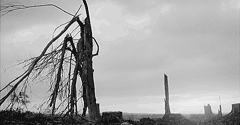Abstract
The La Cueva de los Muertos Chiquitos site (AD 660-1430) is located just north of Durango, Mexico. A reanalysis of the human remains from this site, excavated in the 1950s by Sheilagh and Richard Brooks, has yielded important new information. This cave site contains at least 25 burials of infants and children (n=21 being 0-3 years of age) and at least three adult burials all associated with the Gabriel San Loma Cultural Phase. Using long bone lengths and radiographic analysis of dental development, age approximations for the subadults were obtained. All of the complete juvenile burials exhibit active cases of non-specific periosteal reactions on the cranium. Sixty percent of these burials also exhibit periosteal reactions on the long bones. In addition, porotic hyperostosis (n=7) and cribra orbitalia (n=5) are present. A number of cases of possible juvenile scurvy (n>5) were also identified.
Taphonomic indicators of the mortuary context revealed evidence of burning and sequenced internment involving matting, burial fabric, and intentional placement of burials provide evidence of ritualized burial treatment. Results from the analysis of coprolites and quids found in the cave (Reinhard, et al. 1988) provide additional information on diet and health. Large quantities of food and extralocal jewelry was also a part of the ritual offering. Vegetative data noting the presence of botanicals used for drug production at the site (Foster 1984), suggests that an unusual occurrence such as ritual sacrifice likely precipitated the deaths of up to 25 infants and children.
DOI Link
http://dx.doi.org/10.7275/R5J10125
Recommended Citation
Crandall, John J.; Martin, Debra L.; and Thompson, Jennifer L.
(2012)
"Evidence of Child Sacrifice at La Cueva de los Muertos Chiquitos (660-1430 AD),"
Landscapes of Violence: Vol. 2:
No.
2, Article 12.
DOI: 10.7275/R5J10125
Available at:
https://scholarworks.umass.edu/lov/vol2/iss2/12
